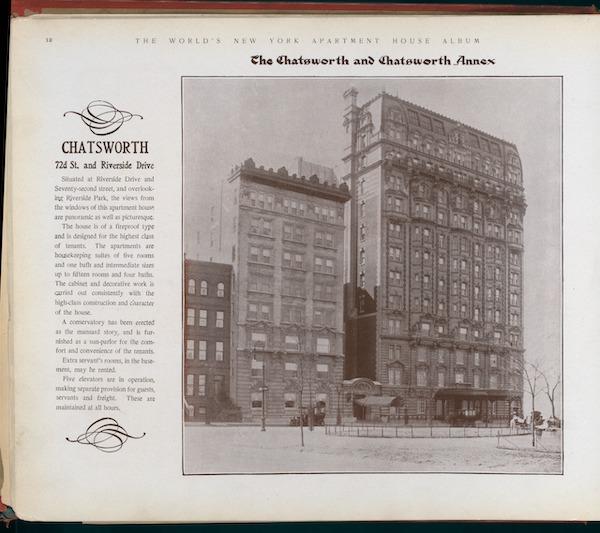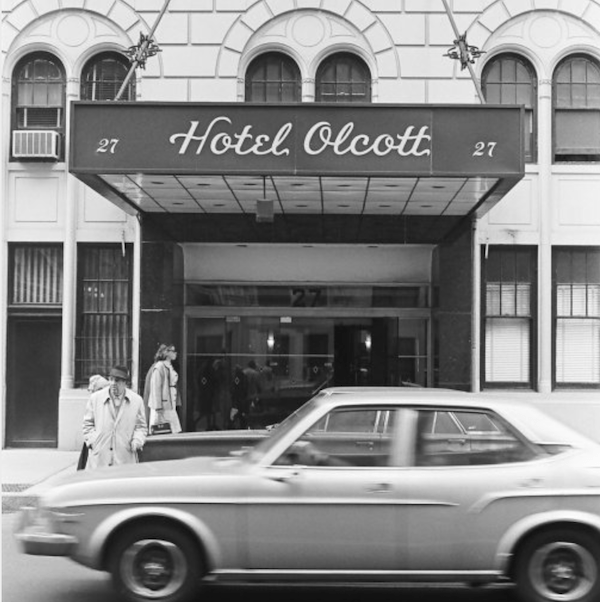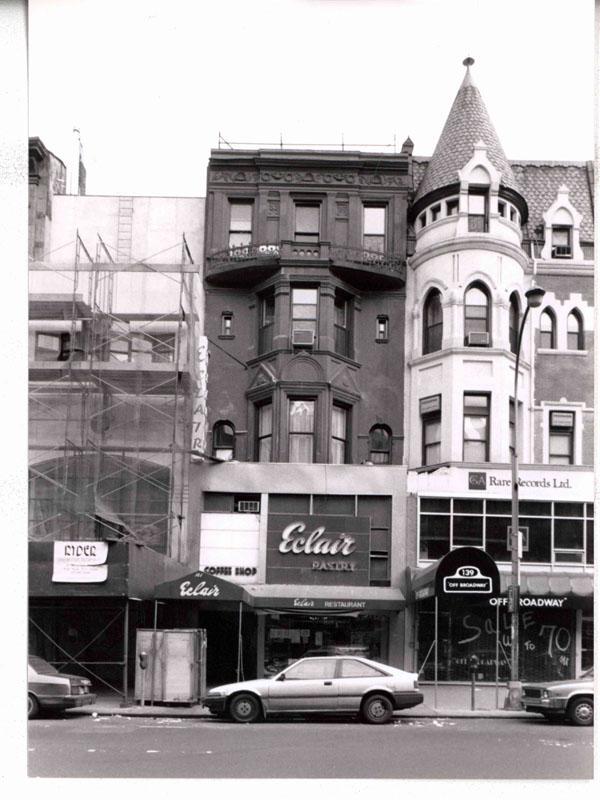
The Chatsworth, 1910. c/o NYPL
In the 1970s, the Chatsworth building at Riverside Drive and 72nd Street was a magnificent, romantic wreck. I lived on the 12th floor. There was little heat inside the apartment, the wind blew through the walls from across the Hudson and on a cold winter day, your teeth chattered.
Advertisement
Still, the views were beyond belief. From three windows the view was straight up the Hudson to the GW Bridge; from the other three, it was west across the river to the Palisades ridge. This was years before the Trump building development blocked the west facing views.
The 1904 floor plan for the Chatsworth found in the book, Apartments for the Affluent: A Historical Survey of Buildings in New York, showed that my apartment consisted of the original library, parlor, dining room and servant’s quarters. As I moved into the building, Walter Iooss, the iconic Sports Illustrated photographer and his wife Eva, a former model, were moving in, while my neighbor, Clive Barnes, the well known NY Times dance and drama critic, was just moving out of what was the larger part of the original apartment.
The ancient paneled elevator had been automated, but there was still an elevator-man who pushed buttons and a managed the opening and closing of an old-fashioned folding elevator gate.
Apartments in the building currently range from $1.97 million to $9.775 million; my pre-renovated rent was just under $500 per month.
ALSO READ: In Awe of Divine Cheesecake: Remembering Miss Grimble’s Bakery
I had always wanted to live at the Chatsworth and got to experience this dream. Later, as a single mom, I wanted change. Out for a walk, I looked up and saw a sign in one of the windows of 260-268 Columbus Avenue (known as the St. Charles.) The sign read “rent $400/mo”, and when I called to ask how many rooms came at that price, the answer I was given was “twelve”. A shabby throw-back to earlier days, this apartment looked south and west with windows letting in a lot of sun.

It was 1977. When my usually adventurous dad came over, he took one quick look. “Too big, too dangerous. If you’re here with your two little children you’ll never know if a stranger gets into the apartment, “ he said. That scared me. It was the one that got away.
Advertisement
On the same block, closer to Broadway, Long’s Bedding recently moved to the East Side. But just before they relocated, still hanging on one of the walls was a piece of history I discovered by chance. It was a photo of King George and Queen Elizabeth (The current Queen’s mother) riding in a motorcade passing Long’s Bedding on 72nd Street. The sidewalks were thronged with people watching and waving to the royals.

The back story is that in 1939, knowing that WWII was imminent, FDR wanted to promote the United States as an ally, so he invited the young couple to visit Washington and New York. They traveled from DC to New Jersey by train, then took the U.S.S. Washington across the river to Manhattan. After an elaborate welcome hosted downtown by Mayor Fiorello LaGuardia and others, the royals were driven at only 25 mph in an open car, so New Yorkers could catch a good look. The route took them up the West Side Highway, across West 72nd Street and on via the Grand Central Parkway to visit the 1939 World’s Fair at Flushing Meadows, Corona Park in Queens.
ALSO READ: From Gilded Age to Chamber of Horrors: Dickensian Extremes at the Astor
Back across Columbus Avenue, about mid-way down the block, the first of many Dallas BBQ restaurants opened in 1978. Located at 27 West 72nd Street in the Olcott Building, it was huge, high-ceilinged and boisterous. The Early Bird Special was a find. A double deal if ordered before 6PM: two rotisserie half-chickens, chicken soup, baked potatoes or fries and cornbread for $10. Dallas BBQ specialized in gigantic frozen margaritas …

Hotel Olcott, 1976. c/o NYPL
Advertisement
But, what was particularly impressive was that diversity was indisputably encouraged here. While other restaurants in the neighborhood at the time did not appear to discriminate against anyone, they also did not consistently have the same joyful mix of customers.

In thinking about 72nd Street over time, one memory in particular always reminds me of the way we often imagine places and people we’ve known, but not seen in a long time, to remain unchanged. My mother loved to go to the Royale Bakery on 72nd Street, not for cakes or cookies, but for frozen cheese blintzes. She swore by them and we had this treat, served with a dollop of sour cream once a week. After the bakery closed, the large lettered Royale sign that was suspended along several stories of the building was not removed. Then, what seems like at least ten years later, I saw a woman walking back and forth searching for something. “Do you know where the Royale Bakery is?” she asked. And, I pointed to the sign that still had not been taken down.





I too grew up on the UWS. 71st betw Columbus and broadway. I remember the Eclair bakery as being a refuge for German Jews who had come after the war. They even had newspapers in German. Also Schwartz candy known for their marshmallows. And blooms bakery and cake masters. 3 bakeries with a few steps of each other all able to make a living.
Thank you for a walk down memory lane! I recently sold my condo on CPW & 97th and spent 45 yrs enjoying the UWS! The best years of my life??
I grew up (70s) on the same block as the Chatsworth. We had spectacular views up to the Hudson. I didn’t realize just how spectacular they were until I went to college and found out that there wasn’t a river, bridge and park outside everyone’s window. We used to rollerskate up to the highway. The Trump buildings weren’t there. I still live nearby and my family still lives in the same apartment. It was a special place to grow up.
Does anyone remember Broadway TV, an electronic sales& repair store: In particular Harvey, the TV repairman? He was my Dad and the job he had doesn’t exist anymore. He was the guy that would fiddle with the tubes and resistors and get it working so you could watch the 4 channels that were on the air!
If anyone remembers the store or Harvey let me know please
I’d love to know if anyone has photos of what 155 E 72nd looked like prior to 1928 when the apartments went up. My great great uncle lived there and it would be really nice to see what the house would have looked like. From the life they lifved, I assume they were pretty wealthy. Does anyone have any idea of whewre I could find some of that area online, Im not in the US so dont have the ability to view in archives etc